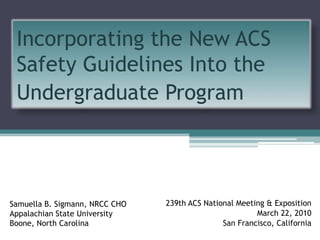
ACS Safety Guidelines Undergraduate Program
- 1. Incorporating the New ACS Safety Guidelines Into the Undergraduate Program Samuella B. Sigmann, NRCC CHO Appalachian State University Boone, North Carolina 239th ACS National Meeting & Exposition March 22, 2010 San Francisco, California
- 3. Support from the chairperson & administration Faculty & Staff dedicated to promoting safe practices Ability to enforce safety Time and Materials to teach safety
- 4. Start With the Basics Traditional Incorporation of Safety
- 5. Traditional Incorporation of Safety Into the Curriculum All incoming students view the ACS “Starting with Safety” video All students must pass the Safety Quiz and sign a Safety Agreement before working in the lab Each experiment details chemical hazards, proper PPE, waste disposal, etc.
- 6. Additionally, TAs for the freshman labs must complete the online safety course and score >80 on the online exam Research students must Complete the online safety course Score 100 on the online exam Complete and sign a check sheet for the lab
- 7. 2008 CPT Guidelines & Evaluation Procedures for Bachelor’s Degree Programs
- 8. 4.5 Chemical Safety Resources Adherence to federal and state regulations regarding hazardous waste management and laboratory safety including - Development of a written chemical hygiene plan Maintenance of proper facilities and personnel for chemical waste disposal Safety information and reference materials PPE readily available to all students and faculty 2008 CPT Guidelines and Evaluation Procedures for Bachelor’s Degree Programs
- 9. 7.3 Laboratory Safety Skills Approved programs should promote a safety-conscious culture in which students understand the concepts of safe laboratory practices and how to apply them. A high degree of safety awareness should begin during the first laboratory course, and… …both classroom and laboratory discussions must stress safe practices. 2008 CPT Guidelines and Evaluation Procedures for Bachelor’s Degree Programs
- 10. Safety Supplement to the Guidelines Safety and Safety Education Safety Supplement to the Guidelines
- 11. Safety and Safety Education – Culture Safety Awareness Development of a positive attitude Faculty that exemplify good safety practice Active & visible safety programs Student participation in safety committees
- 12. Safety and Safety Education – Topics Hazard Identification Methods to Minimize or Reduce Risk Hazard & Risk Information
- 13. Safety and Safety Education Safety Procedures & Processes Training Chemical Hygiene Plan/Safety Rules Emergency reporting system Inspections Risk assessments for research projects
- 14. Designing a Safety Course Topics that address the Guidelines & Emphasize the Safety Culture
- 15. While all laboratory courses teach safe chemical practices… An undergraduate lecture based safety course can emphasize the development of “A Safety Culture”
- 16. Adding a Lecture Safety Course to the Curriculum will better Prepare chemists for industry Prepare the next generation of academic research chemists Teach information gathering skills Raise safety to an equal status in the curriculum with other areas of chemistry
- 17. Chemical Safety A One Credit Hour Course
- 18. Course Topics Safety Agencies Historical Overview the Regulatory Agencies A Culture of Safety Risk Assessment Causation & Incident Reporting Safe Processes OSHA Regulations Governing Laboratories 1910.1450 v. 1910.1200 The Laboratory Standard 29 CFR 1900 1450
- 19. Course Topics, cont. Chemical Hygiene & Emergency Response Plans Health and Hazards Toxins Managing Chemicals Safely Safe Solvent Handling Labeling and Inventory Control
- 20. Course Topics, cont. The Material Safety Data Sheet Personal Protective Equipment Respirators Spills and Waste Management Fume Hoods Compressed Gases
- 21. Text and Readings Prudent Practices in the Laboratory: Handling and Disposal of Chemicals (The National Academies Press) Safety in Academic Chemistry Laboratories, 7th Edition, Accident Prevention for College and University Students (Volume 1) & Faculty and Administrators (Volume 2), by the American Chemical Society's Committee on Chemical Safety The NIOSH Online Pocket Guide to Chemical Hazards
- 22. Particularly helpful sites for teaching NOAA's site CAMEO Chemicals - http://cameochemicals.noaa.gov/ NIH's ChemIDPlus Advanced - http://chem.sis.nlm.nih.gov/chemidplus/ CSB's site - http://www.chemsafety.gov/default.aspx
- 23. Evaluation Online quizzes (Lab Standard & MSDSs) Create an MSDS 2 or 3 Exams Standardized ACS Final Exam
- 24. Activities Students are taken on an tour of our newly renovated stockroom Students are shown the temporary waste accumulation site
- 25. Future Improvements Course Mock lab inspections Design an online version of the course Department Make the safety course required for our majors Require research students to include a risk assessment in their research proposal Occupational H & S concentration
- 26. Course Materials http://www.4shared.com/ Use email sigmannsb@appstate.edu and “safe4u” as the password Check links and regulations for your state
